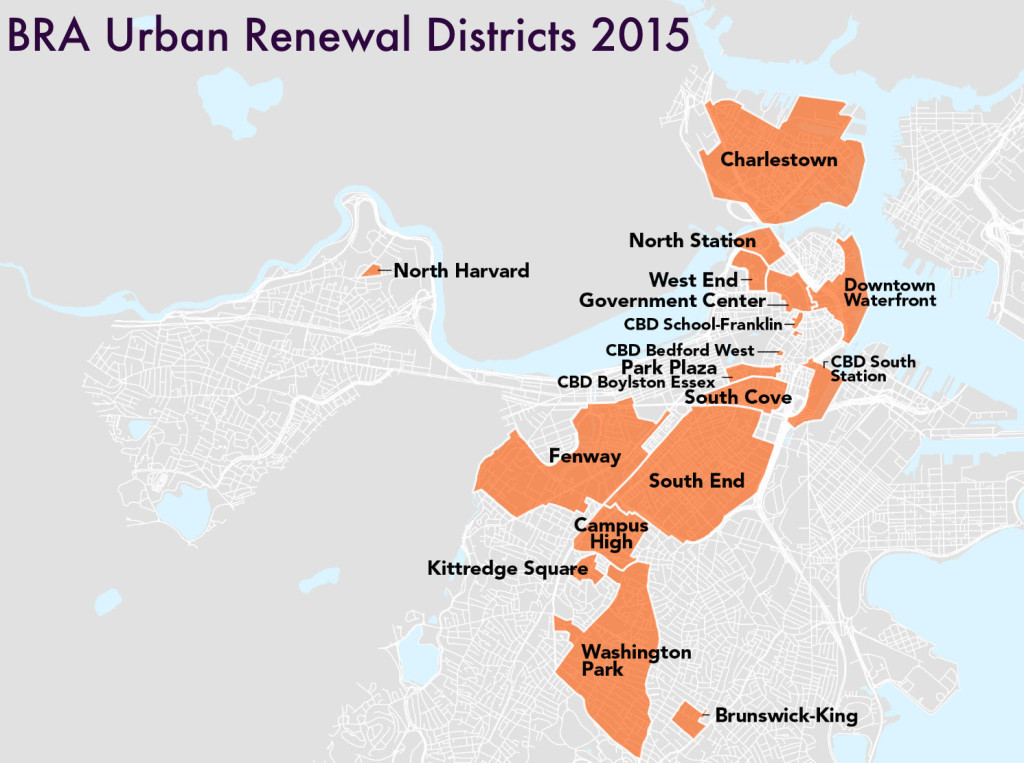
For those of you who have had questions regarding the BRA’s Extension of its Urban Renewal Plan areas, we thought we would offer some information regarding the plan and the ongoing process of approving its extension. If you are interested in reading about the South End Historical Society’s official position on the Urban Renewal Plan Extension, you can read our letter to the BRA here.
Urban renewal began as a federal program in 1949 to address “blight” in cities across America. Boston’s Urban Renewal agency,The Boston Redevelopment Authority, is currently seeking to extend Boston’s urban renewal plan agreements, including jurisdiction over the South End and its historic district. This jurisdiction was established in the mid-20th century at a very different period in the South End’s history and involves, among other things, an extension of the BRA’s eminent domain rights in the district.
There are many concerns among South Enders that this extension of the Urban Renewal Plan is not appropriate for our historic neighborhood. Many others have questions: What role, if any, should redevelopment have in the historic district? Since the South End is not considered a “blight” by the city, what can the BRA really do for the neighborhood? How will eminent domain powers factor into the extended Renewal Plan?
Please read below for some useful context from SEHS Membership Chair, Antony Hill:
SOME BACKGROUND:
Public Meeting Violations
“The BRA’s last effort to extend its urban renewal powers in 2004 led to allegations of back-room dealing between authority officials and city councilors. A Superior Court ruling found that some of those dealings constituted violations of the state’s Open Meeting Law.” (Boston Globe, Casey Ross, Dec. 17, 2014) The initial summary judgment was upheld in a 2008 appeal (McCrae vs Flaherty).
KPMG Audit
An audit, by KPMG LLP focusing on monitoring and enforcing agreements with developers, collecting rents and managing documents, found systems to be inadequate or non-existent. “It faulted the BRA, and its sister agency, the Economic Development Industrial Corp., for failing to follow standard business practices – from filling out employee evaluations to tracking the spending of millions of dollars in housing funds.” (Boston Globe, Casey Ross, July 2014). In the same article, the current head of the BRA, Brian Golden, (first appointed in 2009 as executive secretary) commented, “If you have no rules, by definition you are operating in an arbitrary universe.”
Removal of Affordable Housing Responsibility from BRA
Organizational changes have been made by Mayor Walsh including stripping the BRA of control of the developer financed $20 million fund for affordable housing. Again, significant problems surrounding the collection of fees from developers were exposed by an audit conducted by KPMG LLP. The Department of Neighborhood Development will now administer these funds.
CURRENT BRA NEIGHBORHOOD MEETINGS:
The BRA wants to avoid another set of lawsuits and has been given a year to correct the previous defects. Unfortunately, as currently structured, there appears to be little opportunity to provide evidence or to express concerns that will reach council members and other key decision makers. After meetings in other neighborhoods, attendees reported that BRA representative did not appear to make notes of participants’ comments. There also appeared to have been no request for clarifications of concerns raised from the audience. The BRA representative is simply doing the job for which she has been hired, which is to sell the extension plan and present the BRA in the best possible light. Attending meetings where different people present on the topic, scripted phrases about “tool boxes” are heard repeatedly. One of those tools is eminent domain, which attendees have been assured will not be readily employed.
FLOW OF DECISION-MAKING:
The sequence of decision-making is:
-First the BRA board must approve the planned extension.
-Then the city council must vote to approve.
-The next step is Mayoral approval.
-The final step is approval by a state agency controlled by the Governor.
People in the neighborhood will naturally hold differing views, depending upon their personal experiences and perspectives. Some express support for the ten-year extension, seeing the possibility of benefits for activities that they favor. Others hope that the Mayor will continue to take responsibility away from the BRA and move planning, (clearly separated from development), directly to a city controlled organization that does not have such a troubled history of administrative problems to overcome (see KPMG audit). Such a move would also allow for accountability through the electoral process. Many others support the suggestion that there be an exemption for any “historic districts” allowing the Federal guidelines to offer protection against inappropriate developments.